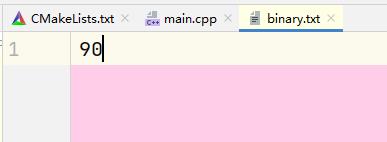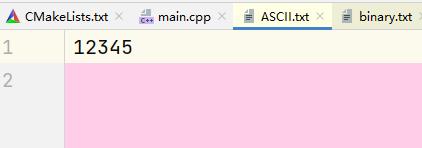C++ 二进制文件 & 顺序读写
Posted 我是小白呀
tags:
篇首语:本文由小常识网(cha138.com)小编为大家整理,主要介绍了C++ 二进制文件 & 顺序读写相关的知识,希望对你有一定的参考价值。
C++ 二进制文件 & 顺序读写
概述
二进制文件不同于文本文件, 它可以用于任何类型的文件 (包括文本文件).

二进制 vs ASCII
对于数值数据, ASCII 形式与二进制形式不同. ASCII 文件直观, 便于阅读, 但一般占存储空间较多, 而且需要花时间转换. 二进制文件是计算机的内部形式, 节省空间且不需要转换, 但不能直观显示.
对于字符信息, 在内存中是以 ASCII 代码形式存放, 无论用 ASCII 文件输出还是用二进制文件输出, 形式是一样的.
二进制写入
#include <fstream>
#include <iostream>
using namespace std;
int main() {
int x = 12345;
ofstream outfile("binary.txt", ios::binary);
outfile.write((char*)&x, 2); // 写入
outfile.close(); // 释放
return 0;
}
输出结果:

ASCII 写入
将 int x = 12345 写入文件.
#include <fstream>
#include <iostream>
using namespace std;
int main() {
int x = 12345;
ofstream outfile("ASCII.txt");
outfile << x << endl; // 写入
outfile.close(); // 释放
return 0;
}
输出结果:

read 和 write 读写二进制文件
打开方式:
ofstream a("file1.dat", ios::out | ios::binary);
ifstream b("file2.dat",ios::in | ios::binary);
文件读写方式:
istream& read(char *buffer,int len);
ostream& write(const char * buffer,int len);
- char *buffer 指向内存中一段存储空间
- int len 是读写的字节数
例子:
将 p1 指向的空间中 50 个字节存入文件对象 a:
a.write(p1,50)
从文件对象 b 读出 30 个字节, 存址指向空间:
b.read(p2,30)
案例一
将数据以二进制的形式存放在磁盘中.
#include <fstream>
#include <iostream>
#include "Student.h"
using namespace std;
int main() {
Student stud[2] = {
{01, "Little White"},
{01, "Big White"}
};
ofstream outfile("student.dat", ios::binary);
if(!outfile){
cerr << "open error" << endl;
exit(1); // 退出程序
}
for (int i = 0; i < 2; ++i) {
outfile.write((char*)&stud[i], sizeof(stud[i]));
}
cout << "任务完成, 请查看文件" << endl;
outfile.close();
return 0;
}
案例二
将二进制文件中的数据读入内存.
#include <fstream>
#include <iostream>
#include "Student.h"
using namespace std;
int main() {
Student stud[2];
ifstream infile("student.dat", ios::binary);
if(!infile){
cerr << "open error" << endl;
exit(1); // 退出程序
}
// 读取数据
for (int i = 0; i < 2; ++i) {
infile.read((char*)&stud[i], sizeof(stud[i]));
}
infile.close();
// 显示数据
for (int i = 0; i < 2; ++i) {
stud[i].display();
}
return 0;
}
以上是关于C++ 二进制文件 & 顺序读写的主要内容,如果未能解决你的问题,请参考以下文章